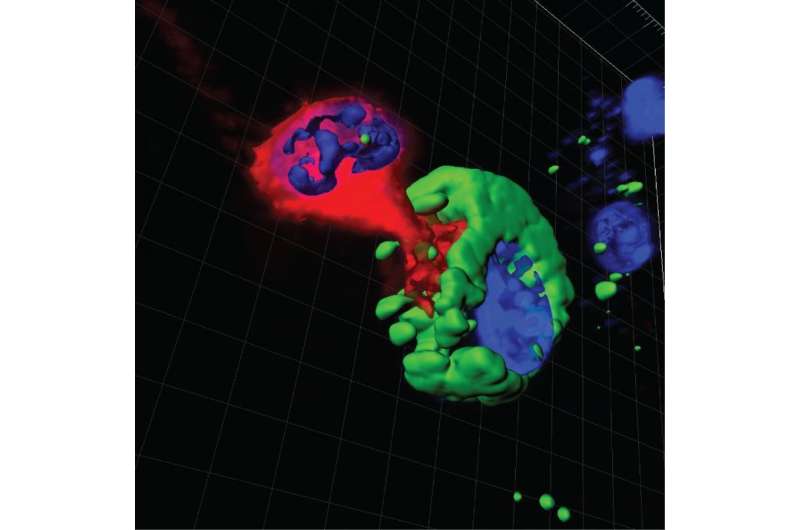Scientists discover new way bacterial infections spread in the body

Bacteria have evolved thousands of clever tactics for invading our bodies while evading our natural defenses. Now, UNC School of Medicine scientists studying one of the world's most virulent pathogens and a separate very common bacterium have discovered a new way that some bacteria can spread rapidly throughout the body - by hitchhiking on our own immune cells.
The new UNC School of Medicine study, published online in the journal eLife, shows that at least two bacterial species are capable of spreading in this manner: Francisella tularensis (F. tularensis), which causes a potentially lethal infection known as tularemia, and Salmonella enterica, a common cause of foodborne illness. The discovery offers a potential way to fight bacterial infections without contributing to one of the world's most pressing public health problems - antibiotic resistance.
"More and more, we've been looking for ways to control disease without specific antimicrobial therapies, because pathogens inevitably develop resistance to those," said Tom Kawula, PhD, professor of microbiology and immunology and senior author. "By figuring out this new way pathogens can disseminate within a host, we can now try to inhibit the host processes involved. If we could inhibit these processes, then pathogens would not develop resistance to treatment."
Kawula and his team have studied F. tularensis for years because of its remarkable virulence. Exposure to as few as 10 of these pernicious microbes can lead to full-blown infection in a matter of hours. Although F. tularensis is not known to spread from person to person, it infects hundreds of animal species and is transmitted from these animals to humans by ticks and mosquitoes. Tularemia symptoms include fever, body pain and respiratory problems; the bacterium has also been developed as a bioweapon.
The discovery revolves around the interaction between F. tularensis and immune cells known as macrophages. Drawing their name from Greek roots meaning "big eater," macrophages are part of the body's first line of defenses against infection. These large cells specialize in detecting foreign invaders, which they typically swallow whole.
Pitting macrophages and F. tularensis against each other in cell cultures, the research team discovered that if macrophages are like knights guarding a castle, then F. tularensis is like an invading army that eludes detection by hiding within the ranks of the knights.
Kawula's team found that the bacteria not only survived inside the macrophages but also interfered with the natural cell death process that is typically triggered in infected cells in order to protect the whole of the organism. The result is that F. tularensis keeps its macrophage host alive for about 36 hours, giving the pathogen plenty of time to spread to other cells.
Even more remarkable was how the bacteria moved from cell to cell: through a little-understood natural process called trogocytosis. During trogocytosis, two cells bump against each other, exchange a few surface proteins and then separate. It was during these brief, hug-like encounters that F. tularensis slipped quietly from one macrophage to another. The study in eLife is the first to show that pathogens can use trogocytosis to infect new cells.
Although trogocytosis usually occurs somewhat infrequently, follow-up experiments revealed that F. tularensis not only takes advantage of the process but also induces macrophages to do it more frequently, thus speeding up the pathogen's rate of spreading.
"If trogocytosis turns out to be crucial to a pathogen's ability to cause disease, we might be able to disrupt this process, even just for a few days, and fight the infection without using antibiotics," Kawula said. Drugs that cause changes within a person's own body, rather than targeting the invading pathogen directly, are more likely to be effective in the long term, he said, because pathogens are less likely to evolve resistance to them.
In addition, the new research provides a foot in the door for scientists to learn more about trogocytosis.
"Nobody knows what drives trogocytosis, but previous studies suggested it is probably involved in the development of immunity and potentially in how the body controls tumors," Kawula said. "Now that we have a bacterial agent that we know increases trogocytosis, we can hopefully leverage that to investigate its role in these other processes, in addition to the spread of infection."
After confirming the role of trogocytosis in F. tularensis infection, the researchers pitted macrophages against a different bacterium, Salmonella enterica. The results showed Salmonella enterica uses the exact same process, albeit at a lower rate of speed. It is unclear whether other bacteria or viruses might spread using the same mechanism.
The paper is titled, "Trogocytosis-associated cell to cell spread of intracellular bacterial pathogens."
More information: eLife, elifesciences.org/content/earl … 16/01/23/eLife.10625
Journal information: eLife
Provided by University of North Carolina Health Care



















